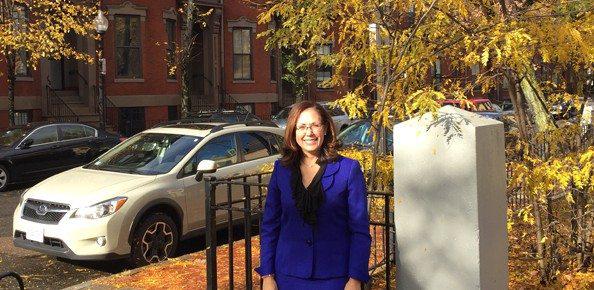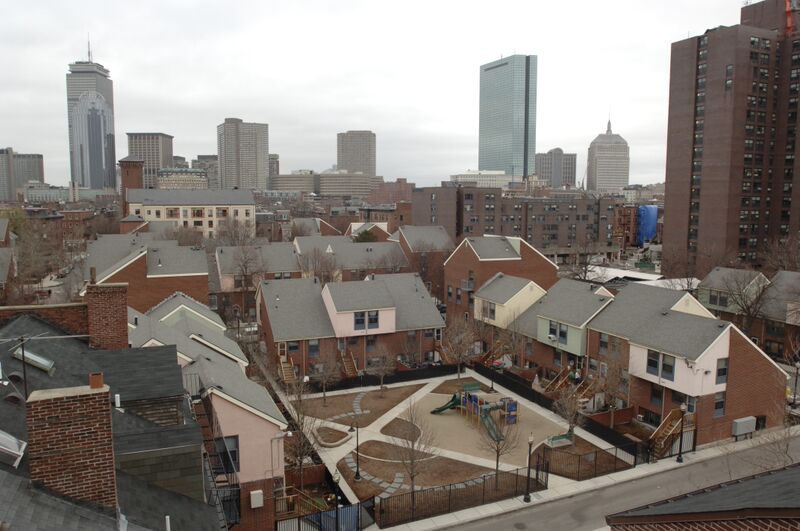
CEO, Vanessa Calderón-Rosado, Interviewed by Banker & Tradesman
Our CEO, Vanessa Calderon-Rosado was recently profiled in Banker and Tradesman, “the financial and real estate services weekly for Massachusetts.” She spoke about our affordable housing plans and shared some of the obstacles we are facing as well as the current state of gentrification in Boston’s South End. You can read all of it below.
Vanessa Calderon-Rosado
Title: CEO, Inquilinos Boricuas en Acción (IBA)
Experience: 24 years
Nonprofit community-building organization Inquilinos Boricuas En Accion (IBA) was formed in 1968 when urban renewal threatened the homes of longtime residents of Boston’s South End. Nearly a half-century later, housing pressures are as strong as ever, with luxury apartment and condominium development booming while waiting lists for affordable housing grow. Vanessa Calderon-Rosado joined IBA in 2003 as its chief operating officer. Now the CEO, she’s leading IBA’s bid to expand its management to nearby housing communities and refinancing its debt to improve its bargaining power acquiring additional properties.
Q: What’s the history of the 435-unit Villa Victoria property?
A: We were founded in 1968 and it was part of stopping the threat of displacement, given the urban renewal plans for this neighborhood. It had already happened in the West End, and it had started happening in what we today call the Ink Block development, which at the time was known as the New York streets. This part of the South End, designated as parcel 19 by the Boston Redevelopment Authority, was next. The primarily Puerto Rican community that lived in this parcel organized to stop the plans and as a result they created IBA to develop affordable housing for redevelopment of the parcel, along with commercial development and a number of services they recognized were needed. They also were a strong force for creation of the Blackstone (Innovation) School, the South End Community Health Center and the Blackstone Community Center. Villa Victoria was developed in phases starting in the early 1970s through the mid-1980s. Today we have 521 units of housing in our portfolio. We have developed about 1,000 units over 47 years. Some of them were turnkey developments to the Boston Housing Authority (BHA). Some of them were homeownership opportunities. Our portfolio is mostly in the South End, but we also have units in Lower Roxbury and Mattapan.
[caption id="attachment_3472" align="aligncenter" width="693"] Villa Victoria[/caption]
Q: How big is your waiting list right now?
A: The waiting list is really a very sad story. In fact, our waiting list right now is close to 12,000 individuals, which just underscores the need for affordable housing in the city. It tells you in a lifetime we will not be able to serve those families. It’s a staggering number. Our turnover is quite low. Our vacancy rate is very low as well. In terms of eligibility, our residents are low-income and very low-income. We have an aging-in-place component and a growing number of elders. Approximately 68 percent of our residents are Latinos and about 26 percent are Chinese.
Q: What are your plans for expanding your affordable portfolio?
A: There’s some property that abuts ours on West Newton Street and the BHA has put out a request for proposals for a total of 146 units. We presented to the BHA two weeks ago. There are two other bidders. We feel that we are the best-positioned developer for the property because of our location – across the street – where we have our program spaces with the art center and preschool program. That was one of our turnkey developments in the late 1970s. These units are a row of brownstones and it’s in a landmark historic district. The idea is to preserve them. Our plan is to rehab the units, HVAC systems, repoint the buildings and do inside renovations. And we’re looking at putting up solar panels. We contract with a security company and we take pride that our community is quite safe. We feel that extending our reach to West Newton Street will benefit the residents by creating a safer environment within the larger South End community. Also, we are a tenant-controlled organization – 51 percent of our board are residents – and those residents from West Newton will be able to run for the board if they want to be given a more direct voice.
Q: What are the income eligibility requirements?
A: Right now it’s $19,000 for a family of two and the rents are $600 to $800 a month in this neighborhood. A brownstone further up on this street would be $3 million.
Q: How is gentrification affecting South End in 2015?
A: That’s one of the biggest challenges. In this neighborhood, it’s extremely hard to acquire property that makes it feasible for development. We have been outbid by private developers who turned properties into luxury apartments and luxury condos. It is still part of our niche, however. We are refinancing part of our portfolio, which is financed through low-income tax credits. We have built great equity in those properties and we will reinvest it in renovations and to be more aggressive in terms of developing housing. If there’s an opportunity that comes along where we can bid a little higher to compete in the neighborhood, those are some things to look at. We’re also looking at our strategic business plan, whether we could densify Villa Victoria. We have already done a preliminary study for areas we feel we could we could build up on our property.
Q: How many additional units?
A: Anywhere from 40 to 70 units. We could build up, or use open spaces that are not currently used.
Q: As a member of Mayor Walsh’s transition task force, what progress do you see on the affordable housing front?
A: The Department of Neighborhood Development put together a housing task force that recommended 53,000 additional units of housing by 2030. The skeptic in me … says those are reports that go onto a shelf to collect dust. A couple of weeks ago, the mayor announced he is going to increase linkage payments and inclusionary development policy funds for development of affordable housing. So I think that is huge progress. The mayor hasn’t said what the new number will be (for the increase in payments). We don’t know what happens to those funds. They go into a black hole at the BRA. They are developing ways to track those funds and make sure they’re used for that purpose. That was a very strong recommendation that came out of the transition report, and it’s happening. I’m sure it’s not going to be enough. But we’ll see. We’ll advocate for more if it gets too low, or we’ll celebrate if it’s the right amount.
Calderon-Rosado’s Top Five Favorite Reads (In No Particular Order):
Villa Victoria[/caption]
Q: How big is your waiting list right now?
A: The waiting list is really a very sad story. In fact, our waiting list right now is close to 12,000 individuals, which just underscores the need for affordable housing in the city. It tells you in a lifetime we will not be able to serve those families. It’s a staggering number. Our turnover is quite low. Our vacancy rate is very low as well. In terms of eligibility, our residents are low-income and very low-income. We have an aging-in-place component and a growing number of elders. Approximately 68 percent of our residents are Latinos and about 26 percent are Chinese.
Q: What are your plans for expanding your affordable portfolio?
A: There’s some property that abuts ours on West Newton Street and the BHA has put out a request for proposals for a total of 146 units. We presented to the BHA two weeks ago. There are two other bidders. We feel that we are the best-positioned developer for the property because of our location – across the street – where we have our program spaces with the art center and preschool program. That was one of our turnkey developments in the late 1970s. These units are a row of brownstones and it’s in a landmark historic district. The idea is to preserve them. Our plan is to rehab the units, HVAC systems, repoint the buildings and do inside renovations. And we’re looking at putting up solar panels. We contract with a security company and we take pride that our community is quite safe. We feel that extending our reach to West Newton Street will benefit the residents by creating a safer environment within the larger South End community. Also, we are a tenant-controlled organization – 51 percent of our board are residents – and those residents from West Newton will be able to run for the board if they want to be given a more direct voice.
Q: What are the income eligibility requirements?
A: Right now it’s $19,000 for a family of two and the rents are $600 to $800 a month in this neighborhood. A brownstone further up on this street would be $3 million.
Q: How is gentrification affecting South End in 2015?
A: That’s one of the biggest challenges. In this neighborhood, it’s extremely hard to acquire property that makes it feasible for development. We have been outbid by private developers who turned properties into luxury apartments and luxury condos. It is still part of our niche, however. We are refinancing part of our portfolio, which is financed through low-income tax credits. We have built great equity in those properties and we will reinvest it in renovations and to be more aggressive in terms of developing housing. If there’s an opportunity that comes along where we can bid a little higher to compete in the neighborhood, those are some things to look at. We’re also looking at our strategic business plan, whether we could densify Villa Victoria. We have already done a preliminary study for areas we feel we could we could build up on our property.
Q: How many additional units?
A: Anywhere from 40 to 70 units. We could build up, or use open spaces that are not currently used.
Q: As a member of Mayor Walsh’s transition task force, what progress do you see on the affordable housing front?
A: The Department of Neighborhood Development put together a housing task force that recommended 53,000 additional units of housing by 2030. The skeptic in me … says those are reports that go onto a shelf to collect dust. A couple of weeks ago, the mayor announced he is going to increase linkage payments and inclusionary development policy funds for development of affordable housing. So I think that is huge progress. The mayor hasn’t said what the new number will be (for the increase in payments). We don’t know what happens to those funds. They go into a black hole at the BRA. They are developing ways to track those funds and make sure they’re used for that purpose. That was a very strong recommendation that came out of the transition report, and it’s happening. I’m sure it’s not going to be enough. But we’ll see. We’ll advocate for more if it gets too low, or we’ll celebrate if it’s the right amount.
Calderon-Rosado’s Top Five Favorite Reads (In No Particular Order):
- “Cien Años de Soledad,” by Gabriel García Márquez
- “Lean In,” by Sheryl Sandberg
- “From Good to Great,” by Jim Collins
- “Don Quixote,” by Miguel de Cervantes Saavedra
- “The Miraculous Journey of Edward Tulane,” by Kate DiCamillo
